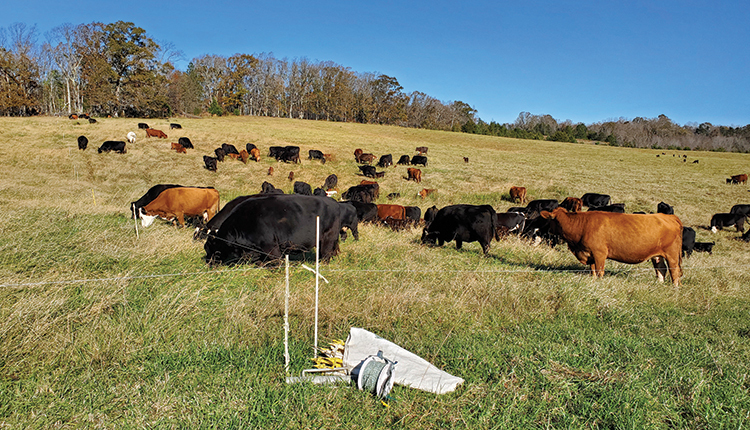Step up your grazing game in 2021 |
| By Matt Poore |
|
|
The author is an extension ruminant nutrition specialist at North Carolina State University. Grazing management is getting more attention these days, but the vast majority of cow-calf producers still use continuous or lax rotational grazing. Actively managed grazing does take effort, but it can be one of the most rewarding activities on the farm. Adaptive grazing is an approach that encourages the grazier to use a combination of grazing techniques to develop their own custom system that is adapted to their personal situation. A successful adaptive grazier knows how to grow a lot of forage, use it with short grazing periods and long rest periods, and maintain at least a moderate amount of residual forage mass after each grazing bout. There are many grazing techniques that can help you apply these principles, and making critical observations each time you allocate pasture will lead to a system of continuous improvement. Recently, due to COVID-19 restrictions, I have been stuck at home on the farm, and this has given me a chance to really focus on my grazing skills. My family runs 110 cows in Virgilina, Va., 50 miles due north of Raleigh, N.C. A mix of strategies My personal favorite grazing technique is “frontal grazing” with a single wire that is moved ahead of the cows. I have been using this technique during calving on our group of first-calf heifers this year, and it works really well since we check them twice a day. We ran 18 heifers in a 10-acre field of novel endophyte tall fescue (MaxQ) for 30 days, and moved the wire about 15 feet twice per day. Moving the wire is as simple as creating a little slack with the reel and then just walking along and moving the step-in posts over. The reel end can be advanced as necessary, so you can use that single wire to cross the whole field. By the time you move the fence, the heifers have lined up to be counted. Our mature cow herd has spent their calving season grazing a stockpiled mix of crabgrass, dallisgrass, and KY-31 tall fescue, and we give them a fresh strip of grass once per day. I am flip flopping two reels to make the daily allocation. It can be a bit challenging to take down the wire with calves tearing around all over the place, but if you keep it tight as you walk and reel it up, you can get along pretty well. This approach only takes me about 20 minutes, and the entire time, I am making observations about the cows and calves. With each of these situations, I only back fence after about two weeks. I like the cows and calves to have plenty of area to spread out when it rains, and for cows to get away from the herd to calve. With fresh grass on the grazing front, the herd is rarely seen in the previously grazed areas. We typically feed our yearling steers and heifers on hay during October as their winter pastures of oats and ryegrass establish. The last two years we have really had trouble with these cattle in muddy conditions due to some wet autumns. This year was shaping up to be wet again, so we decided to try bale grazing. Bale grazing consists of putting out enough hay for the specified period of time (45 round bales for 30 days in this case) and then rationing it out using electric fence. As the cattle clean up each set of bales, the next fence is taken down and the rings moved to the new bales. This approach prevents a lot of damage to the land that happens when you drive frequently to deliver hay into wet pastures. Polywire is powerful Each of these advanced grazing practices requires a good understanding of temporary electric fencing. The key is to have a lot of power on your fence. Cattle really respect a hot wire, so if you can get the power high and check it often enough to find problems as they develop, you can totally change the behavior of your cow herd. There may be individual cows that don’t adapt to the system, but that is a pretty rare occurrence. Once the cattle are trained to the temporary fence, there are many benefits beyond the ability to ration out nutrition in an adaptive grazing system. When cows get into a rhythm with a system, they become more and more docile and easy to manage. You will be able to sort off cows using a reel of polywire. You will be able to use a reel of polywire to reduce the number of people you need in the working pen. You will be able to fence off damaged areas that need to rest and limit access to shade when cows don’t need to be under trees. You can even put cows into a narrow section and spray them for flies! If you don’t use advanced grazing techniques in your beef cow program, I encourage you to consider it. Use your internet browser to search for “The Power of One Wire” and “Twelve Step Plan to Amazing Grazing.” This article appeared in the January 2021 issue of Hay & Forage Grower on page 9. Not a subscriber? Click to get the print magazine |
